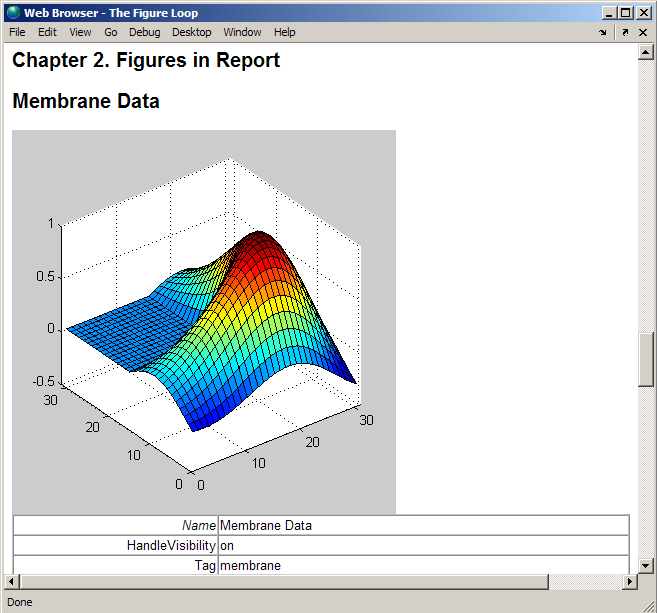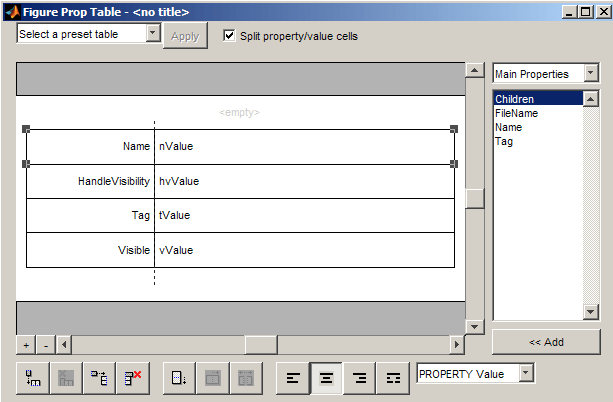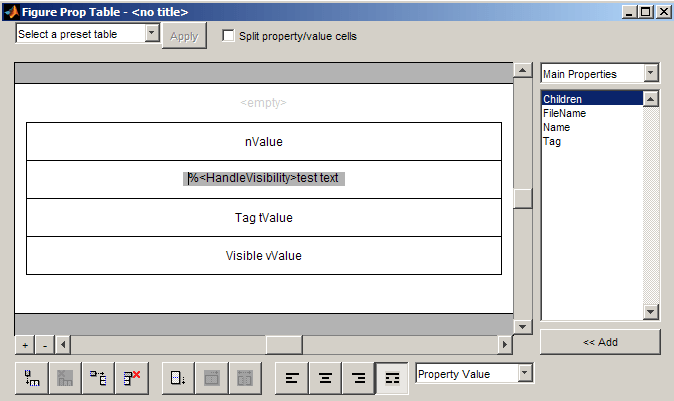属性表组件
属性表组件显示表中对象的属性名称/属性值对。以下示例显示了来自 figloop-tutorial 报告的属性表。

有多种类型的属性表组件可用,其中包括:
MATLAB® 属性表
Simulink® 属性表 (需要 Simulink Report Generator™)
Stateflow® 属性表 (需要 Simulink Report Generator)
本例中使用的组件代表 MATLAB Report Generator 属性表组件,它们都表现出类似的行为。
打开示例报告模板
此示例使用 figloop-tutorial 报告模板。要打开报告模板并显示 Handle Graphics 图窗,在 MATLAB 命令提示符下,输入:
openExample("rptgen/FigureLoopReportExample")检查属性表输出
所有属性表组件的属性页的形式都相似。在“大纲”窗格中,选择 Figure Prop Table 组件。要修改表设置,请在 Handle Graphics® 属性表对话框中点击编辑... 按钮。

选择对象类型
属性表组件提供了要报告的多个对象类型。例如,Handle Graphics 属性表允许您报告图窗、坐标区对象或 Handle Graphics 对象。
您可以在组件的属性窗格中的对象类型列表中选择要报告的不同对象类型。
显示属性名称/属性值对
拆分属性/值单元格
在 Handle Graphics 属性表组件的属性窗格中,清除拆分属性/值单元格复选框。
点击编辑。该表现在处于非拆分模式。非拆分模式支持每个单元格和文本有多个属性名称/属性值对。

要使属性名称和属性值出现在表中相邻的水平单元格中,请选中拆分属性/值单元格复选框。表现在处于拆分模式。拆分模式仅支持每个单元格一个属性名称/属性值对。如果单元格中出现多个属性对,则报告中仅会出现第一对;所有后续属性对都会被忽略。

显示选项
属性名称/属性值对可以以多种方式出现在单元格中。要指定给定的属性名称/属性值对在单元格中的显示方式,请在表中选择该字段(对于本教程,选择名称属性)。从对话框底部的显示选项下拉列表中选择值。在选定的表行中,仅显示值。

格式选项
要指定给定单元格中文本的对齐方式,请在对话框底部的工具栏中使用四个对齐按钮。
选择 HandleVisibility 表行。然后选择双对齐按钮(右边的最后一个按钮)。

编辑表格标题
表标题可以包含属性和文本。默认情况下,表的标题与 %<Name> 属性的值相同。您可以修改此属性来修改表标题。
注意
表标题始终处于非拆分模式。
在表单元格中输入文本
为了使文本可见,表必须处于非拆分模式。清除拆分属性/值单元格。
要将文本输入到 HandleVisibility 表单元格中,请双击该单元格。出现一个灰色框,其中带有单元格属性的标记。

如果在尖括号外键入文本,则文本将按原样显示在报告中。尖括号内的文本必须指定有效的属性名称。如果输入了无效的属性名称,则报告中会显示该属性名称,但没有属性值。
在表中添加、替换和删除属性
添加表属性
要向表添加 Handle Graphics 属性,请使用以下步骤。
在图窗属性表窗口中,选择要在其上方添加新属性的表行。
点击在当前单元格上方添加行
 按钮
按钮当前行上方出现一个新行。
将该属性添加到新表行。
选择新的表行。
在对话框右上角的“属性类型”下拉列表中,选择属性类型。
在属性列表中,选择要添加的属性。
点击<< 添加按钮,或双击属性名称。该属性出现在表行中。
或者,如果您知道要添加的属性的名称,请按照 在表单元格中输入文本 中所述直接在单元格中输入属性名称。有关添加新表行的信息,请参阅 添加和删除列和行。
替换表属性
要在拆分模式下替换表单元格中的属性,请按照 添加表属性 中的说明进行操作。
注意
当表处于非拆分模式时,您不能使用这些步骤删除单元格中的属性。
删除表属性
通过退格键或使用删除键来删除属性。
格式化表列、行和单元格
添加和删除列和行
要添加或删除列或行,请选择一个单元格,然后点击下表中描述的按钮之一。
注意
当某行或某列是表中唯一的行或列时,您不能删除该行或列。
按钮 | 操作 |
|---|---|
 | 添加列(添加到选定列的左侧) |
 | 删除选定列 |
 | 添加行(添加在选定行的上方) |
 | 删除选定行 |
调整列大小
要调整列的宽度,请根据需要点击并拖动其垂直边框。
合并和拆分单元格
要合并或拆分表单元格,请选择一行,然后点击下表中描述的按钮之一。
按钮 | 操作 |
|---|---|
 | 向下合并单元格 |
 | 向右合并单元格 |
 | 拆分单元格 |
显示或隐藏单元格边框
要打开或关闭单元格边框:
将光标放在单元格中并右键点击以调用其上下文菜单。
选择 单元格边框 > 上、下、右侧或左侧来打开或关闭指定的边框。
缩放和滚动
您可以使用位于水平滚动条左侧的缩放按钮来放大和缩小表。
按钮 | 操作 |
|---|---|
|
| 放大 |
|
| 缩小 |
您可以使用表滚动条垂直和水平滚动。
选择表
要显示属性名称/属性值对,您可以选择预设表或使用自定义表。
内置并格式化了预设表。您可以在图窗道具表窗口左上角的预设表选择列表中选择一个预设表。要应用预设表,请选择该表并点击应用。
要创建自定义表,请选择预设表并通过添加和/或删除行和属性来修改它以满足您的需要。您可能希望从 Blank 4x4 预设表开始。
注意
您不能将自定义表保存为预设表。如果这样做,您将丢失对自定义表的所有更改。

